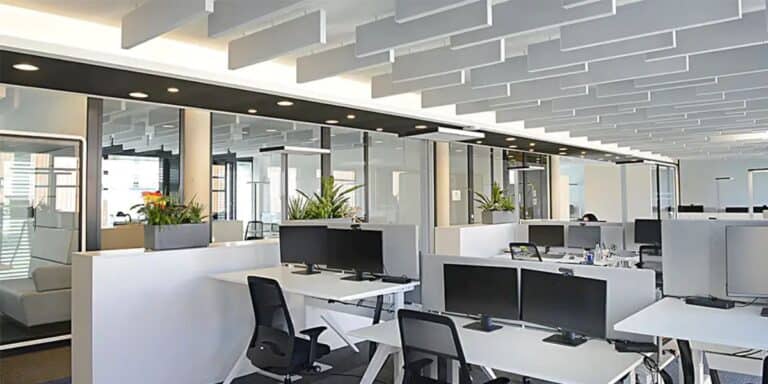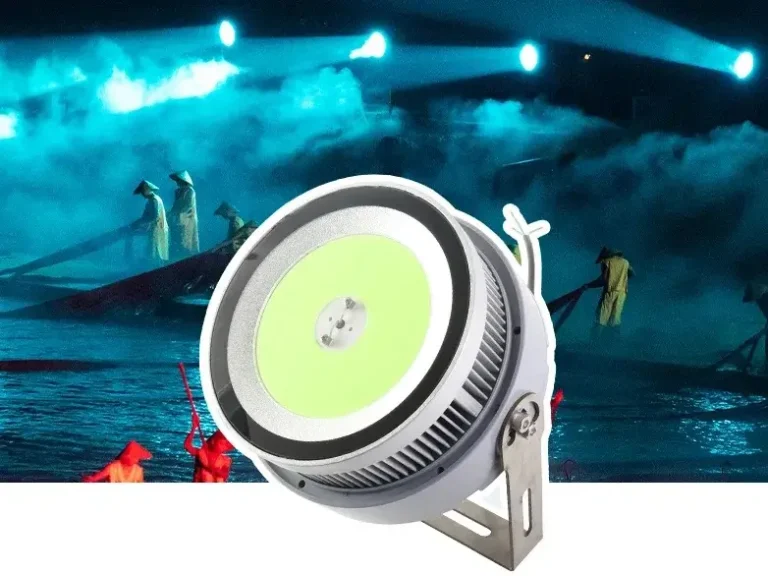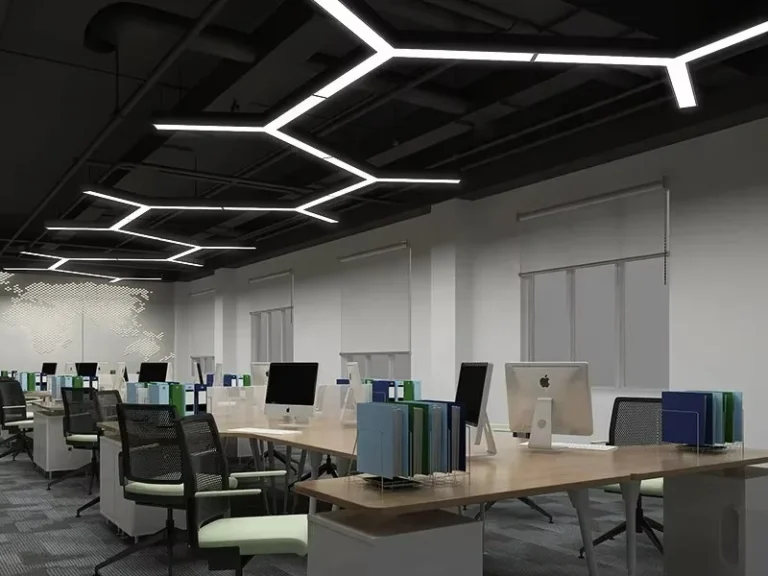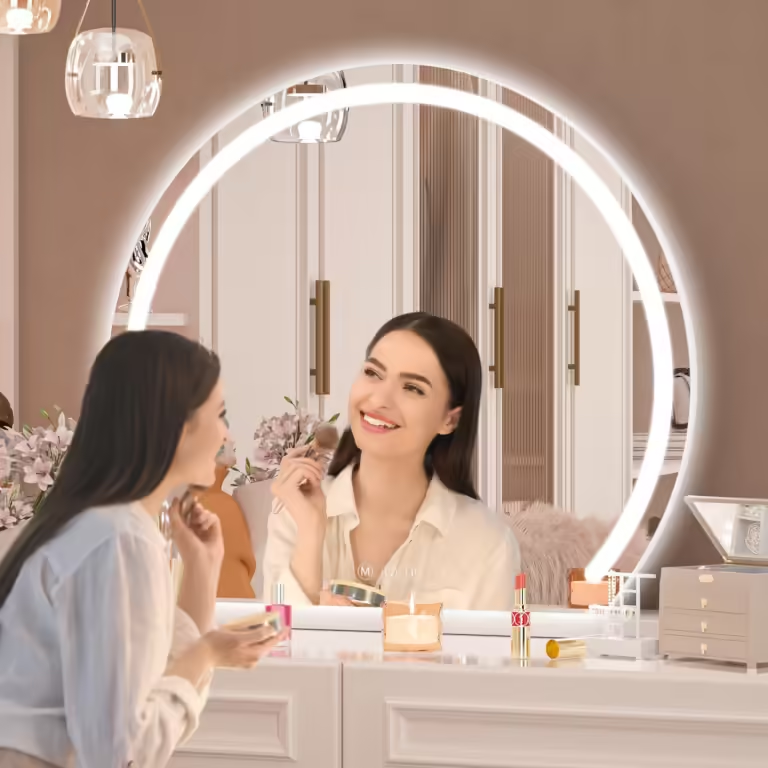In commercial lighting and home design, LED linear lights are widely popular for their sleek design and uniform light distribution. However, neglecting the Unified Glare Rating (UGR) may lead to visual fatigue or even safety hazards. We can achieve a comfortable experience of “seeing light without seeing the light source” by selecting the appropriate lighting scientifically.
According to international standards, different scenarios have clear requirements for UGR. Offices and classrooms usually require UGR≤19, while some high-end exhibition halls and hospitals have higher requirements for UGR, requiring UGR≤16. Therefore, UGR has become an important factor that cannot be ignored when purchasing LED linear lights.
Can LED linear lights achieve a UGR of less than 19?
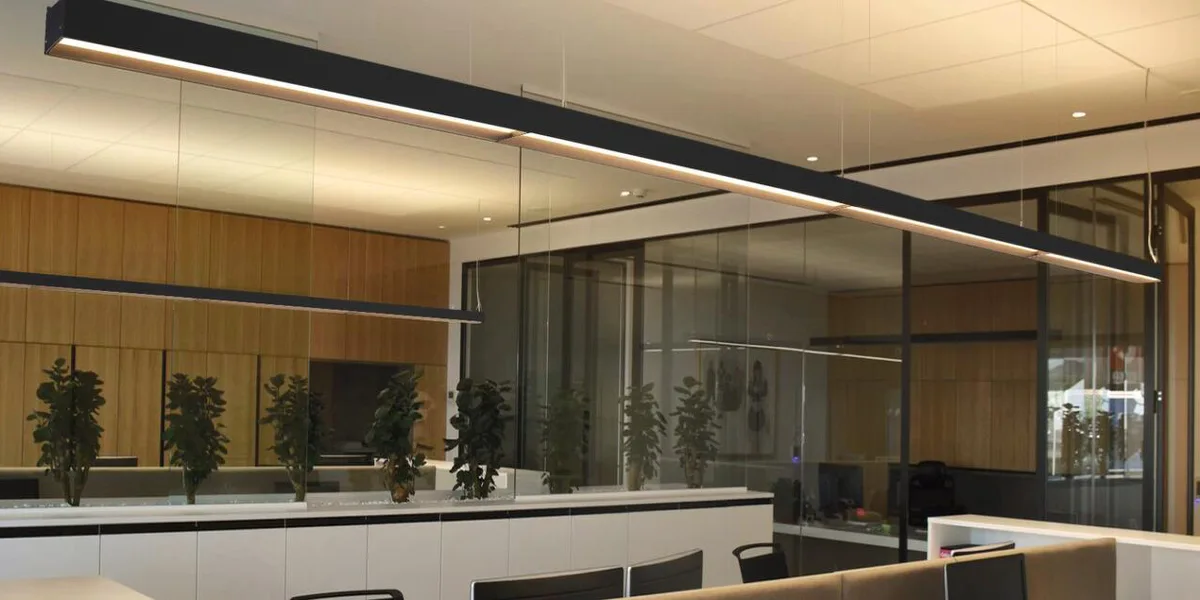
Yes, LED linear lights can achieve a UGR of less than 19. The Unified Glare Rating (UGR) is a key parameter for measuring the glare effect of lighting. Healthy lighting environments such as offices require a UGR of less than 19 to ensure visual comfort. For example, LED linear lights designed specifically for low glare can stabilize the UGR value below 19 through micro-structured anti-glare optical materials, which complies with building lighting standards.
However, as a direct lighting source, linear lights may pose glare risks if improperly designed. As shown in the actual measurement data below, their UGR values can reach 22, exceeding the CIE recommended upper limit, leading to discomfort such as frequent pupil contraction and headaches. Therefore, when selecting products, it is advisable to prioritize those explicitly labeled as meeting the UGR requirements.
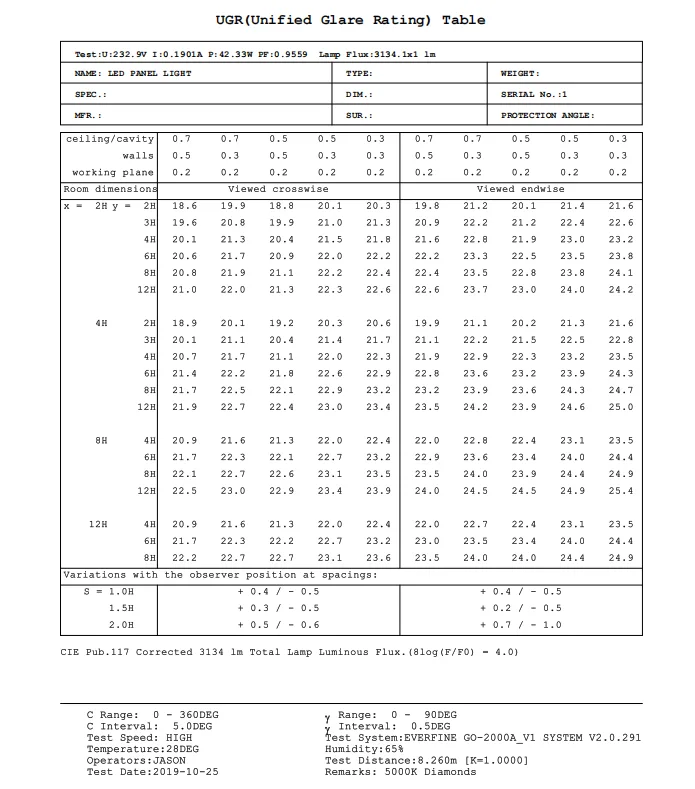
Why should the glare rating (UGR) of linear lights be less than 19?
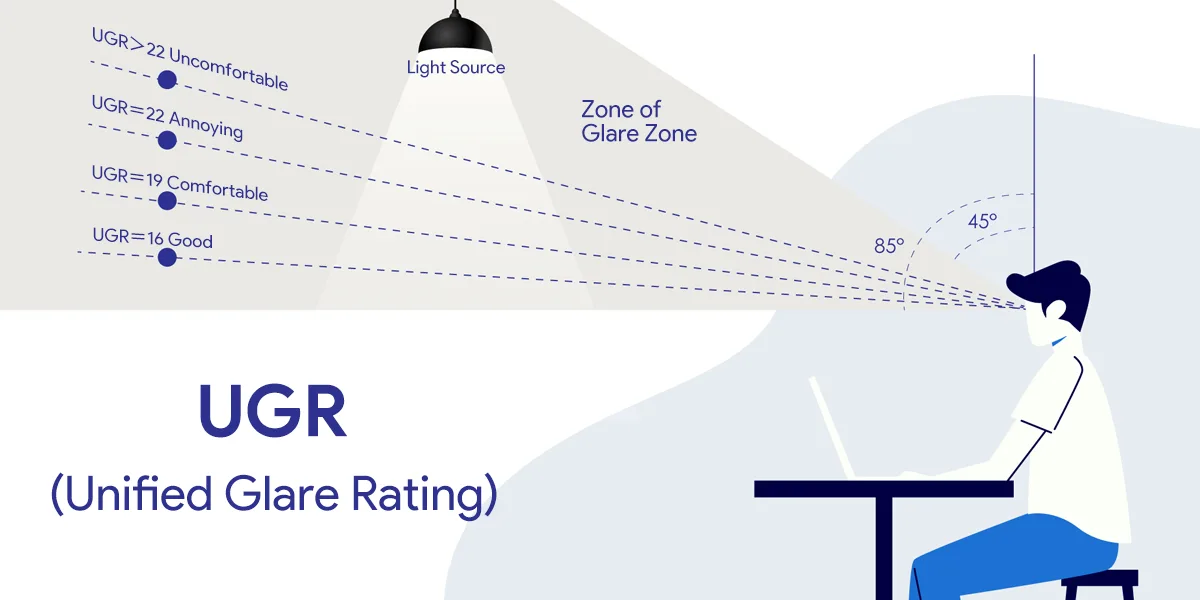
UGR (Uniform Glare Rating) is an internationally recognized standard for assessing the glare level of indoor linear lighting. The lower the UGR value, the weaker the glare and the higher the visual comfort. The UGR value is influenced by multiple factors, including light source brightness, position, and ambient light levels.
When UGR exceeds 19, the pupils frequently adjust, leading to visual fatigue. Prolonged exposure can cause retinal damage, vision deterioration, and an increased risk of cataracts. In China alone, where over 60% of adolescents suffer from myopia, glare pollution has been identified as one of the primary contributing factors.
Current standards require that UGR values in healthy lighting environments be below 19. The requirement for UGR to be less than 19 is primarily based on the following reasons:
- Ensuring visual comfort: A UGR value of 19 marks the threshold between moderate and significant glare. When UGR ≥ 19, the sensation of glaring light significantly increases, potentially causing visual fatigue or discomfort. However, when UGR < 19, glare remains within an acceptable range, making it suitable for environments such as offices and classrooms where prolonged focus is required.
- Adapting to workplace requirements: In office areas and other environments requiring precise visual tasks, the UGR ≤ 19 standard balances illuminance and comfort, preventing glare from interfering with work efficiency. For example, the GB50034-2013 standard explicitly stipulates that the UGR upper limit for general office areas is 19, simulating the comfortable experience of natural light environments.
- Distinguishing application scenarios: The graded design of UGR values considers the tolerance levels of different locations—UGR < 19 is suitable for high-demand environments (such as offices), while UGR ≥ 19, which causes noticeable glare, is only recommended for industrial facilities or stores where visual comfort requirements are lower.
How is the UGR value graded?
The comfort grading of the UGR value (Uniform Glare Rating) has been clearly defined by international standards. The specific comfort thresholds and applicable scenarios are as follows:
When UGR < 13, the light is soft, and the human eye can hardly perceive glare. This is suitable for spaces with extremely high visual comfort requirements, such as art galleries and high-end residences.
When UGR < 16, it falls within the comfort range, with slight glare that does not impair visual tasks. This is the recommended standard for classrooms, reading rooms, and other environments requiring precise work. For example, eye-protective panel lights in classrooms must control UGR ≤ 16 to protect the vision of adolescents.
UGR Value and Human Perception State Grading
| UGR Range | Human Perception | Applicable Scenario Examples |
| UGR < 13 | No perceptible glare | Hospitals, high-end exhibition halls, special institutions |
| 13 ≤ UGR ≤ 16 | Mild glare | Hospitals, senior activity centers |
| 16 ≤ UGR < 19 | Moderate glare, acceptable but may cause fatigue | Ordinary offices, meeting rooms |
| 19 ≤ UGR < 22 | Threshold for noticeable discomfort | Industrial plants, warehouses |
| UGR ≥ 22 | Intense glare, causing headaches | Avoid prolonged human occupancy |
The psychological threshold between comfort and discomfort is UGR = 19, but healthy visual environments (such as learning spaces) should aim for UGR ≤ 16.
Mandatory standards for application scenarios:
- Educational facilities: Mandatory UGR ≤ 19 for classrooms; high-quality lighting solutions should be optimized to ≤ 16;
- Office environments: UGR > 19 causes frequent pupil contraction leading to visual fatigue; the qualifying score is ≤ 19;
- Industrial sites: UGR ≤ 22 is permitted, but anti-glare accessories must be used to reduce health risks.
Glare Protection Practice Recommendations
| Measures | Technical Principles | UGR Reduction Effect |
| Micro-prism Diffusion Panel | Decomposes high-intensity light beams | Reduces to ≤16 |
| Indirect Lighting Design | Avoids the 30° interference zone around the human eye | Reduces by 30% |
| Low-Gloss Materials | Reduces environmental reflection glare | Optimizes by 2-3 points |
Note: UGR measurements require a distributed photometer with a fisheye lens; calibration is needed if the error exceeds ±10%.
UGR Requirements for Linear Lighting in Europe and the United States
Europe and the United States have clear grading standards for UGR requirements for LED linear lighting. The specific regulations and implementation points are as follows.
Mandatory UGR Grading Standards
EU Core Standards: All indoor linear lighting must meet the minimum safety threshold of UGR ≤ 19. Exceeding this value will result in failure to obtain CE certification. Special locations have stricter requirements: Education/office areas: UGR must be ≤16, such as classrooms and open-plan offices; art galleries/medical facilities: UGR must be ≤13, and honeycomb anti-glare structures must be used.
North American Special Requirements: UL 1598 standards explicitly require LED lighting fixtures to control photobiological hazards (excluding the 4400-780 nm wavelength band); Energy Star certification requires commercial lighting fixtures to have UGR ≤ 22 and must indicate blue light levels (the RG0 exemption level is prioritized).
UGR Measurement Acceptance Specifications
| Item | EU Standards | North American Supplementary Requirements |
| Observation Height | Seated 1.2m / Standing 1.5m | Adheres to CIE 117-1995 standard |
| Measurement Equipment | 143° field of view imaging luminance meter | Must pass UL photometric calibration |
| Background Brightness Correction | Eliminates direct light interference from fixtures | Adds mirror reflection detection item |
Comparison of UGR Standards Between Europe and North America
| Indicator | EU | North America |
| Enforcement Strength | UGR > 19 prohibited from market circulation | Energy Star certification voluntary enforcement |
| Technical Focus | Glare control (UGR) as core focus | Photovoltaic safety + energy efficiency dual control |
| Upgrade Direction | Implement UGR ≤ 16 by 2025 | Strengthen safety standards for button battery accessories (UL4200A) |
| Core Thresholds | UGR ≤ 19 Mandatory threshold (CE certification basic requirement) | No federal-level mandatory threshold; Energy Star recommends ≤ 22 |
| Special Scenario Requirements | Educational/medical facilities UGR ≤ 13 | Industrial lighting permitted UGR ≤ 25 (must meet UL 1598 electrical safety standards) |
Optical Parameter Collection
- EU: Mandatory use of a 143° field of view imaging luminance meter to eliminate interference from direct light from the luminaire;
- North America: Must pass UL photometric calibration equipment and add mirror reflection detection.
Observation Reference
- The EU uniformly adopts a seated height of 1.2 m/standing height of 1.5 m for eye level;
- North America aligns with EU standards but allows manufacturers to define their own test heights (subject to registration).
European countries will implement mandatory requirements for mirrored ceilings with UGR≤16 coverage (including commercial spaces) starting in 2025.: luminaire surface brightness ≤2000 cd/m²; frosted lampshades with reflectance <60%.
Wireless-controlled lighting fixtures must additionally comply with: FCC radio frequency certification (47 CFR Part 15), and button cell battery accessories must comply with UL 4200A3.
Trend alert: The EU’s new regulations in 2025 will incorporate photobiological safety (RG0) into the UGR assessment system, and North America will simultaneously upgrade UL 153 blue light control standards.
How to measure the UGR value of LED linear lights?
The UGR value of LED linear lights is commonly measured using a goniophotometer, which can obtain photometric data and simulate calculations using standard software. The following are the specific testing procedures and key points:
Secure the linear light fixture to the rotating mount of the goniophotometer. By rotating the fixture or the reflector, capture the light intensity distribution data across a 360° space, generating an IES-format photometric file containing parameters such as luminous flux and light intensity distribution.
Long linear lights typically belong to the category of biaxially symmetric fixtures (e.g., long panel lights), requiring testing of the light distribution curves for two symmetric planes: the longitudinal plane (C0-C180) and the transverse plane (C90-C270).
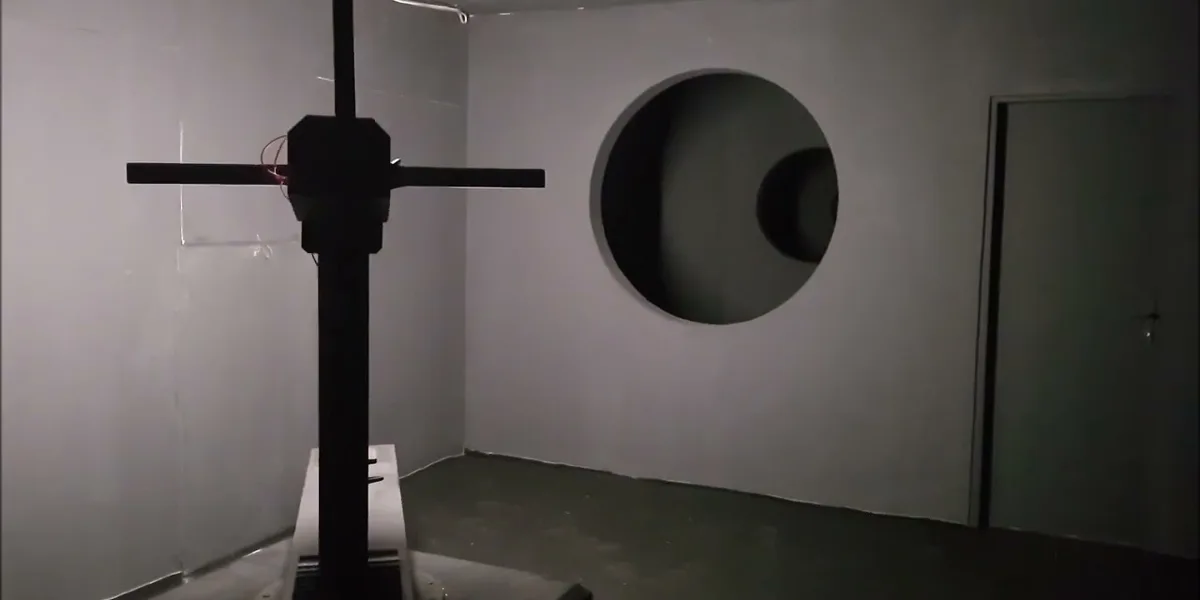
Data validation
Ensure that the IES file contains complete light distribution information (such as half-peak edge angle and beam spread angle), and that the luminous solid angle ω of the luminaire is within the range of 0.0003 to 0.1 sr to meet the UGR calculation conditions.
Importing the IES file into simulation software
When loading the IES file of a linear light fixture into professional software such as DIALux, confirm that the file is in a fully symmetric or biaxially symmetric format (asymmetric fixtures cannot generate UGR tables). If the IES file does not automatically adapt, adjust the symmetry using a correction tool.
Set up the standard simulation environment
According to CIE 117-1995 standards, construct a virtual room and define key parameters:
- Space dimensions: Set length and width dynamically according to X=2H, 4H, 8H, 12H (where H is the height from the observer’s eyes to the luminaire installation height);
- Reflectance: Enter the actual reflectance coefficients for the ceiling and walls (default values: ceiling 0.7, walls 0.5);
- Observer position: Maintain a horizontal line of sight, with a default distance from the luminaire’s center point.
- Generating the UGR table and correction: The software outputs the “Reference UGR Illuminance Assessment Table” (Uncorrected UGR Table), which represents the theoretical values for the bare light source at 1000 lm luminous flux.
- Actual UGR correction formula: Actual UGR = Table value + 10 × log(actual light flux of the luminaire / 1000). For example, when the light flux of the luminaire is 2000 lm, add 3 to the table value (10 × log₂ ≈ 3).
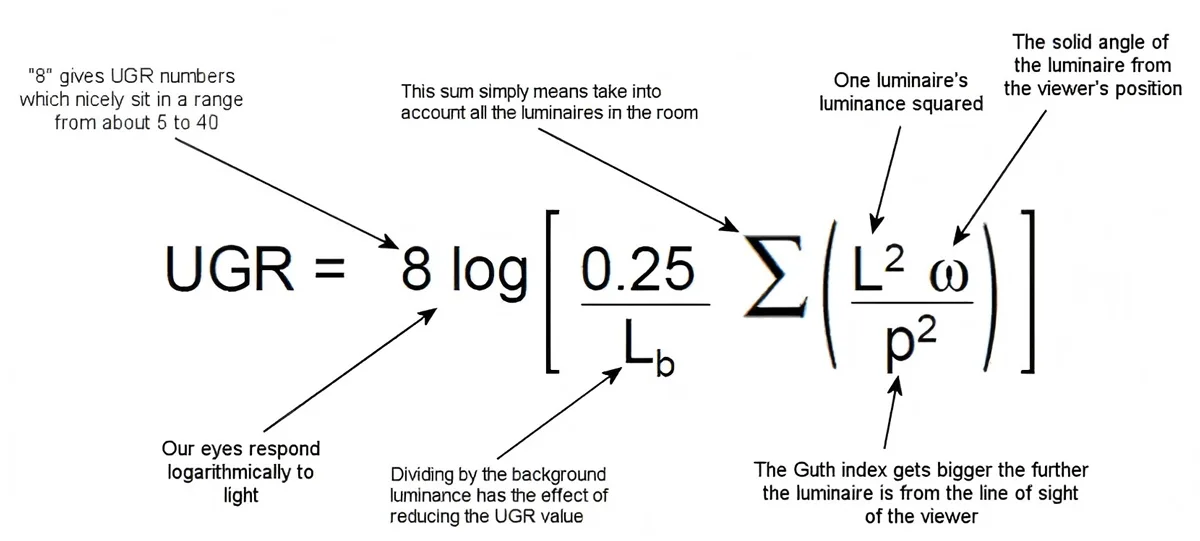
- Application limitations: UGR is only applicable to indoor environments and bilaterally symmetric luminaires; linear luminaires with polarized designs (such as non-symmetric distribution wall-washing luminaires) cannot be directly evaluated using this method.
- Differences between measured UGR and simulation results: Simulation results are standard environmental reference values; actual installations are influenced by spatial dimensions, reflective materials, etc.
How to effectively reduce the UGR value of linear lights?
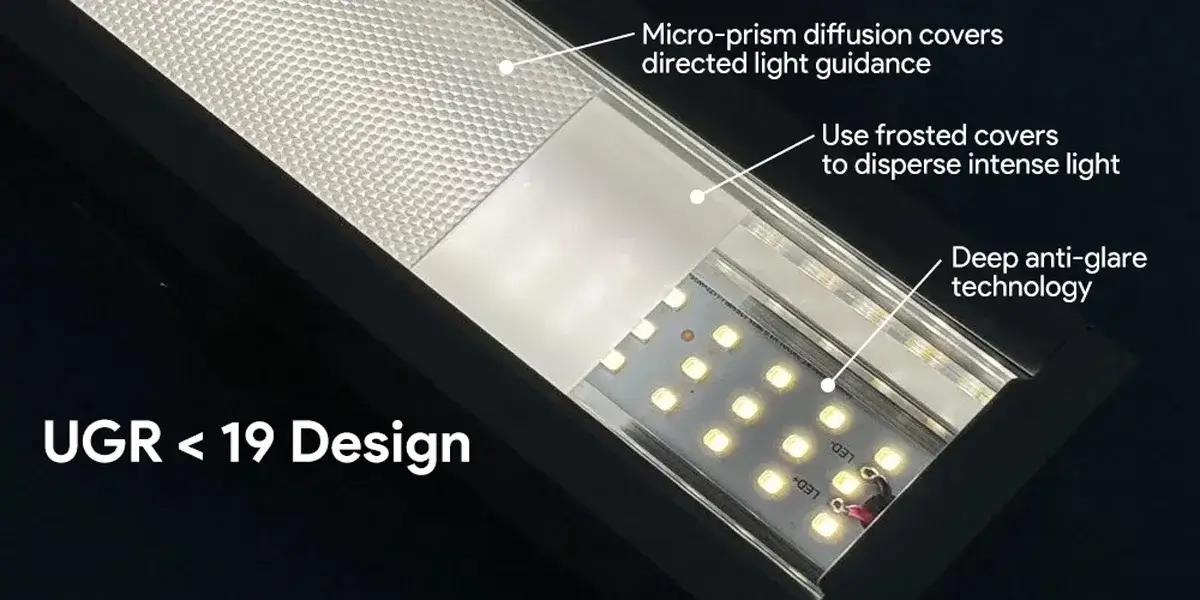
- Optical structure optimization: Adopt a glare angle design and deep anti-glare technology, with a glare angle of ≥25 cm to block direct light from reaching the eyes. For industrial settings, it is recommended to install the lights at a height of ≥3.5 m and combine them with reflectors to reduce glare.
- Surface Treatment Technology: Use a honeycomb anti-glare mesh to weaken stray reflections, achieving a 30% reduction in UGR (especially suitable for high-reflectivity environments); alternatively, use frosted/matte lampshades to disperse intense light, ensuring uniform light diffusion, with a surface reflectance of <60%;
- Micro-Prism Diffusion Panels: Directed light guidance, reducing UGR from 21 to 14.
- Installation and Layout Control: Prioritize recessed installation to avoid exposed lamps; linear lights should be embedded in ceilings or walls (embedded depth ≥2cm); when surface-mounted, polarized lenses must be used to direct light toward the work surface. Lamps must not be placed within 30° of eye level (a height of ≥1.8 m above the ground is safer); mirrored ceilings must be paired with frosted lampshades to suppress secondary reflections.
- Wall Material Control: Use matte paint (reflectance <60%), avoiding high-reflective materials such as white walls or tiles; install curved reflective light slots to convert direct light into diffuse light (measured UGR reduced from 21 to 13).
- RG0-Level Blue Light Control: Use full-spectrum light sources to reduce photobiological stimulation;
- Smart Dimming System: Dynamically reduce contrast in high-brightness areas (must be FCC/CE certified).
- Notes: Transparent LED bulbs are exposed light sources and can cause severe glare; avoid high-power dense arrangements, with lamp spacing ≥ 1.5 times the width of the luminaire; reflective surfaces such as mirrored furniture, desks, and screens should be offset from the luminaire’s projection angle.
- Effect Verification: Measure the corrected UGR value using a 143° field-of-view imaging luminance meter to ensure ≤19 (office) or ≤13 (medical/educational).
Additionally, to meet UGR ≤19, lighting projects must employ triple-technology control:
- Optical Design: Use micro-structured light diffusion plates to reduce surface brightness;
- Strategy: Avoid the human eye interference zone (within a 30° upward field of view);
- Material Selection: Use low-gloss materials to reduce reflective glare. For example, classroom lighting is mandated to have UGR ≤ 19 (National Standard GB7793-2010), while high-end fixtures (such as streetlights) are further optimized to UGR ≤ 16.
- Optical Optimization: Install micro-prism diffusion panels: UGR can be reduced from 21 to 14; use polarized lenses: industrial settings allow UGR ≤ 25, but must be paired with walls having a reflectance of ≤ 60%.
- Installation Taboos: Strictly prohibit placing bare lamps within the 30° horizontal field of vision of the human eye; a height of 1.8 meters above the ground is safer; in mirrored ceiling settings, frosted lampshades must be used.
SignliteLED LED Linear Light’s Four Core Advantages
Exceptional Optical Performance: Featuring a glare-reduction design with UGR < 19, the light is evenly diffused through a prismatic diffusion panel, complemented by a high-precision optical lens system that effectively controls the sharpness of the light spot boundary, achieving museum-grade glare suppression standards.
Industrial-Grade Structural Design: Constructed with aerospace-grade aluminum alloy profiles and nano-coating technology, it boasts an IP66 protection rating, capable of withstanding extreme environments from -30°C to 60°C. Its innovative modular assembly structure supports multi-dimensional adjustment from 0° to 90°, accommodating installation in curved or irregular spaces.
Smart Ecosystem Integration: Built-in DALI/PWM dual-protocol driver, compatible with mainstream smart control systems. Graphene heat dissipation technology achieves over 93% energy efficiency conversion, combined with a lifespan of over 50,000 hours, saving over 40% energy compared to traditional lighting fixtures.
Differentiated Value: The product is certified by CE and RoHS, offering a 5-year warranty. Customized service systems can accommodate special color temperature (adjustable from 2700K to 6500K) and color rendering index (Ra ≥ 95) requirements for commercial spaces, art galleries, and other scenarios.
With their outstanding optical performance, durable industrial-grade structure, smart control compatibility, and highly customized services, SignliteLED’s LED linear lights have become the ideal choice for modern architectural lighting and high-end commercial spaces. Whether you are undertaking a new construction project or a lighting upgrade, SignliteLED can provide you with more efficient, smarter, and more design-oriented lighting solutions.
